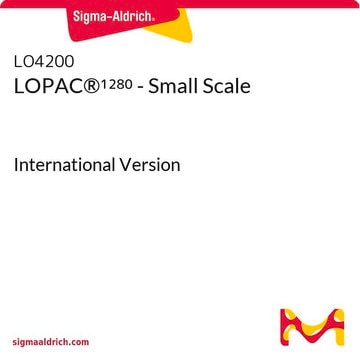LO1280
LOPAC®1280
Synonyme(s) :
Library of Pharmacologically Active Compounds
About This Item
Produits recommandés
Forme
liquid
Conditions d'expédition
dry ice
Température de stockage
−20°C
Description générale
Application
- in the screening of novel inhibitors for chemotaxis/ migration using Dictyostelium as a model
- to test the ability to modulate and to measure forskolin-stimulated cAMP levels in CHO-hCB2 cells and to modulate ligand-induced receptor/β-arrestin interaction
- in screening of small molecules for activating bone morphogenetic protein (BMP) signaling
- in screening of compounds that plays a role in regulating subcellular localization of nitric oxide associated protein 1 (NOA1) protein
Caractéristiques et avantages
- Apoptosis
- G Proteins & Cyclic Nucleotides
- Gene Regulation & Expression
- Ion Channels
- Lipid Signaling
- Multi-Drug Resistance
- Neurotransmission
- Phosphorylation
- Structure
- Primary Name
- Secondary Name
- Pharmacological Activity
- Product Number
- Rack Position
Autres remarques
Informations légales
Mention d'avertissement
Danger
Mentions de danger
Classification des risques
Acute Tox. 2 Dermal - Acute Tox. 2 Inhalation - Acute Tox. 2 Oral - Aquatic Acute 1 - Aquatic Chronic 1 - Carc. 1A - Eye Dam. 1 - Lact. - Muta. 1B - Repr. 1A - Resp. Sens. 1 - Skin Corr. 1B - Skin Sens. 1 - STOT RE 2 - STOT SE 2
Code de la classe de stockage
6.1A - Combustible acute toxic Cat. 1 and 2 / very toxic hazardous materials
Point d'éclair (°F)
188.6 °F - closed cup
Point d'éclair (°C)
87 °C - closed cup
Certificats d'analyse (COA)
Recherchez un Certificats d'analyse (COA) en saisissant le numéro de lot du produit. Les numéros de lot figurent sur l'étiquette du produit après les mots "Lot" ou "Batch".
Déjà en possession de ce produit ?
Retrouvez la documentation relative aux produits que vous avez récemment achetés dans la Bibliothèque de documents.
Les clients ont également consulté
Articles
Explore compound library screening options with our Pharmacologically Active Compounds portfolio.
Notre équipe de scientifiques dispose d'une expérience dans tous les secteurs de la recherche, notamment en sciences de la vie, science des matériaux, synthèse chimique, chromatographie, analyse et dans de nombreux autres domaines..
Contacter notre Service technique
![N'-HYDROXY-1-METHYL-2-[2-(PHENYLSULFANYL)ETHYLIDENE]HYDRAZINECARBOXIMIDAMIDE SULFATE AldrichCPR](/deepweb/assets/sigmaaldrich/product/structures/273/761/717af332-cc45-4118-bbbe-4103581033f2/640/717af332-cc45-4118-bbbe-4103581033f2.png)











